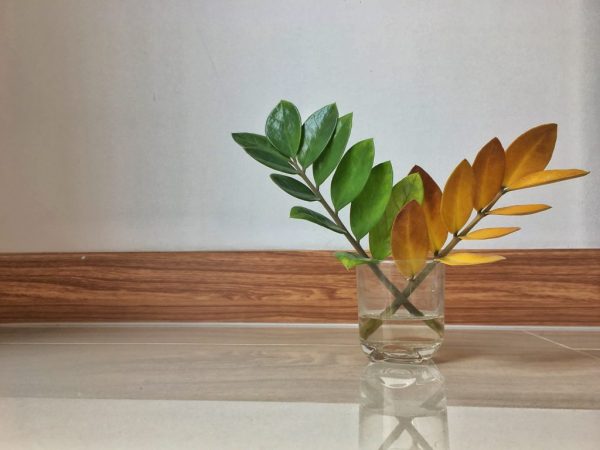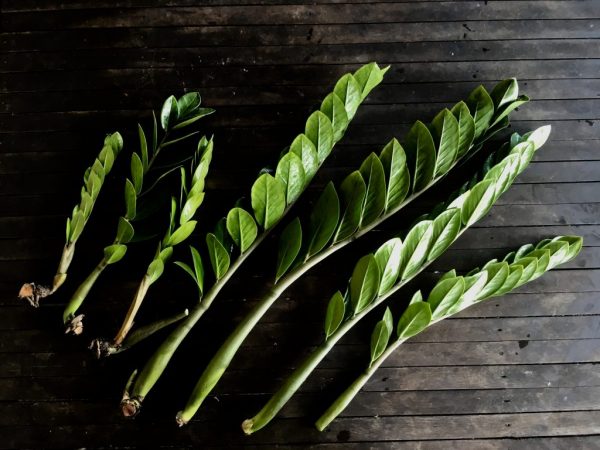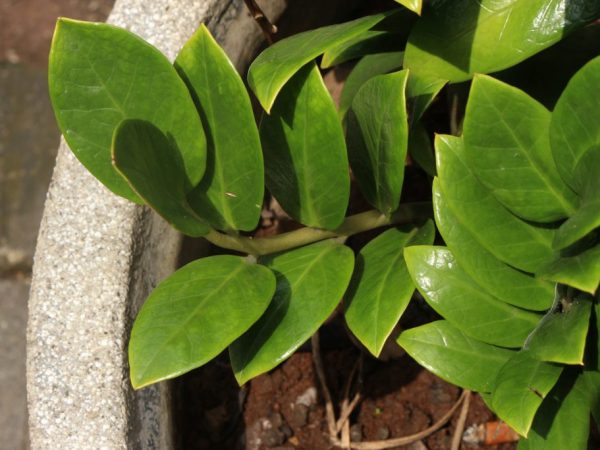Reproduction of Zamioculcas - how to carry out the procedure at home
Zamioculcas is an exotic flower from distant Africa. Caring for a plant at home does not cause any particular difficulties, but reproduction can become problematic if a number of conditions are not met. Time, method, and technology matters - it is important to do everything right.

Reproduction of Zamioculcas - how to carry out the procedure at home
Breeding rules
It is better to start in early spring - in March-April.
By this time, the dollar tree is already emerging from hibernation, the buds have swollen, the rudiments of new leaves have appeared.
The heating season in the apartments is not over yet, which means that the conditions are just right for the successful reproduction of the flower.
Humidity should be 40-50% or less. The temperature is needed not lower than +20 ° С.
Even if the flowerpot is next to the battery, the cuttings will take root perfectly.
The ways
Zomyokulkas reproduces in several ways, each of them has its own characteristics. Some make it possible to immediately get a full-fledged bush, and after others, an adult plant will have to wait several years.
Cuttings
Cuttings are cut from a large branch of zamiokulkas. It should be fully formed, with uniform dark green leaves.
If at the end of the branch the leaves are light green, smaller than the rest, it is not suitable, because it has not accumulated enough nutrients.
Stages:
- The long shoot is cut into separate pieces with two paired leaves each (as well as 4-6 leaves each). From one branch, at least 10 of them are obtained.
- The cuttings are laid out on a newspaper and allowed to dry until the milky juice no longer stands out from the cut. Then they are dipped in Korenvin for an hour.
- Prepare a nutrient substrate in advance. It should be lightweight with good air exchange. A mixture of perlite and vermiculite in equal proportions is perfect for these purposes. Some people mix vermiculite, perlite, coarse sand, polystyrene and soil.
Attention! Do not use peat as a substrate. In it, the plant will not be able to take root and will die.
Cuttings are placed in a container with a substrate, to a depth of 2-3 cm, then you need to cover it with a jar on top or build a greenhouse. Do not water! Only after 3-4 days, the ground around the stem is lightly sprayed with a spray bottle.
Full watering is started no earlier than 2 weeks later. The cutting takes root for 2-3 months (in the greenhouse a little faster).
Leaf propagation
Small leaves are separated from the long branch, cuts are made in the region of the petiole, and they are put to dry. Then it is dipped in Kornevin and placed in a substrate.
If a greenhouse is not necessary for cuttings, then it must be organized to root the leaves. Both a regular bank and film shelters are suitable.
Containers with sheets are placed in a warm, bright place.The temperature should not be lower than +25 ° С. It is not necessary to water the cuttings - it is better to spray the ground.
Watering is allowed only after 2 weeks. But only with warm, settled water and a little bit. Zamioculcas does not tolerate overflow, especially its young shoots.
Dividing tubers

You can divide the tuber only in an adult flower.
This is not a simple planting of a bush, but the division of one tuber into several. In an adult zamiokulkas, the tubers grow to large sizes. On one "bulb" you can find 2-3 points of growth - living healthy kidneys.
If you cut the tuber into pieces so that these buds are divided, several independent bushes are formed.
To propagate in this way only adult (from 3 years old) bushes, healthy and strong, will turn out.
It is better to start dividing in early spring, when the flower has already woken up and is ready for active growth. Stages:
- It is taken out of the pot completely, shaken from the ground.
- The largest tubers are laid aside, the rest are returned back to the same container (if the task is not to plant the entire bush).
- With a sharp, clean knife, cut the tuber between the buds.
- The cut site is dipped in a fungicide, sprinkled with activated carbon and placed in a substrate. It should completely cover the tuber. If there are healthy leaves, they are left uncut.
It is not necessary to form a greenhouse - in a warm place, the tuber will grow without problems. In a few months, new leaves should appear.
Seeds
This is the most time consuming breeding method, but very fun. The first problem faced by a florist is where to get high-quality planting material?
Seeds of home zamioculcas do not fully ripen under normal apartment conditions. They are unlikely to ascend even if all the required conditions are met. Therefore, it is better to buy from them in nurseries and greenhouses from experienced specialists.
Stages:
- The seeds are soaked in a growth biostimulator (Previkur Energy, Epin Extra, Ecosil) for 2-3 hours.
- Then they are sown on a substrate consisting of vermiculite, perlite and coarse sand.
- From above, the container is covered with glass or film and placed under the lamp. It is better to use an ordinary incandescent lamp - it gives both light and heat at the same time.
The temperature should be within + 25-29 ° С. Under these conditions, seedlings will appear in 10-14 days. You should not remove the glass immediately - you need to accustom the sprouts to room temperature gradually. Only after the appearance of 4 leaves can you begin to remove the greenhouse.
Attention! It is imperative to remove condensation from glass! On hot days, ventilate the greenhouse for 10-15 minutes.
Rooting cuttings in water
After separating small leaves from a branch, you can try to root them in water. Previously, each sheet is processed in the following preparations:
- Kornevin;
- Heteroauxin;
- Zircon.
The leaf is placed in a small container of water at the very bottom so that the petiole barely touches the moisture. If there is a lot of water, the leaf will simply rot.
Some growers advise to raise the leaf above the water and fix it so that the roots reach for the moisture on their own. It is believed that this way the roots will appear faster, and the risk of leaf decay will also be eliminated.
Follow-up care

Seedlings need to be well looked after
After rooting the planting material, it is important to properly care for it so that the seedlings gain strength and begin to actively grow. Whether the flower survives depends on the conditions and care. Experienced flower growers know the basic secrets of care.
Watering
The first time after planting, the seedlings are not watered, but irrigated around the trunk. This is especially important for seed-derived sprouts. They are very delicate and easily rot at the slightest flooding.
- Seedlings propagated by dividing the bush can be watered after a week.
- Rooted leaves are not watered for the first month, but spray the ground around.
- The cuttings can be watered with a little warm water after 3 weeks.
For young flowers, the watering regime depends on the size of their root system. Zamioculcas does not tolerate excess moisture and reacts sharply to overflow.
Lighting
The dollar tree loves bright light, but young shoots from the direct sun must be shaded. Their delicate foliage is prone to burns. Placing flowerpots on the southeast or south windows would be ideal.
The sprouts are drawn to the light, so they must be periodically turned, if the light falls from only one side, the flower will stretch out and become disproportionate, one-sided.
However, you cannot change the location of young plants. Even “moving” to another room can be very stressful for them.
Top dressing
Young sprouts do not fertilize for the first 3 months. Later, fertilizers for cacti and succulents are introduced in liquid form (at the root) 2 times a month.
The best ready-made complexes suitable for zamiokulkas are:
- Biopon;
- Good power;
- Activin;
- Reasil;
- Fertis.
Temperature and humidity
After rooting, the sprouts need warmth. The temperature should not drop below +25 ° С. Otherwise, their growth will slow down, and immunity will decrease.
Humidity should not be high - 40-50% is sufficient. However, sometimes the sprouts need to arrange a cool "shower" by spraying them with a spray bottle.
A high level of humidity weakens the zamioculcas. In cloudy weather, it should not be additionally watered or sprayed. For the first year, you need to protect the flower from rot, which affects both the upper part of the plant and its still not strong roots.
Young sprouts of zomyokulkas are not afraid of drafts. On the contrary, fresh air is good for them.
Even newly rooted cuttings are exposed in front of an open window - the plant will feel comfortable in warm sunny weather. Of course, if it's cold outside, you shouldn't ventilate the seedlings.
Pruning and replanting
The plant is sheared if they want to give the bush a certain shape or dense crown.
Damaged or dried branches should also be removed. Especially if the disease is the cause.

Transplanting time depends on the age of the plant.
A young zamioculcas is transplanted once a year, an adult - once every 2-3 years.
Technology:
- The pot is chosen 2-3 cm larger in diameter than the previous one.
- A large drainage (clay shards, expanded clay) is laid out on the bottom. Then a finer baking powder (vermiculite, gravel). The next layer is soil mixed with foam and perlite.
- The plant is removed from the pot and simply transferred into a new container as a whole. At the same time, the roots are not shaken off or separated.
Such a transplant is the least traumatic for a flower.
How to plant zamioculcas
As the tubers grow, they interfere with each other, the plant stops growing, withers and may even die.
When a bush grows, it must be planted at least once every 3-4 years.
Technology: the plant is completely removed from the pot, the earth is shaken off, then the roots are washed off with warm water. Examine the tubers, carefully separate them. At the same time, the tubers are left intact and intact.
The smallest tubers are allowed to be collected and planted in one smaller pot. Seating them in separate containers is not very convenient - it takes a lot of containers and consolidated space in the house. In addition, they will have a better chance of surviving, because individually they have not yet accumulated enough nutrients.
Possible problems
After the plant has been propagated, growers often face problems associated with the further growth and development of young seedlings. Some of them are easy to solve, and some require special attention and intervention of specialists.
Stopping growth
Zamioculcas is very slow in growth. But it happens that after rooting the cuttings or dividing the tubers, the plant stops growing completely.
You should not immediately overfeed it with fertilizers or try to water more. It will only make it worse. Most likely, the flower takes time to get used to the home microclimate and grow.
Leaf burns
An adult zamiokulkas needs a lot of light, but it is better to shade young specimens from open rays.
Under the direct sun, the foliage begins to ache, burns appear, the plant withers and disappears.
Overflow
The dollar tree does not tolerate excess moisture, so watering should be very moderate. This is especially true for the dormant period of the plant (October-March).
If watering is frequent and supplemented with irrigation on the leaf, then the plant begins to rot - the leaves darken and fall off.
If an adult bush can still cope with decay by growing new roots instead of rotten ones, then the young one will die immediately.
Summing up
Reproduction of zamiokulkas is a fascinating and not too complicated process. The main thing is to follow the basic rules and observe the conditions for caring for young plants.
From one adult bush, you can get a lot of material for planting and rooting.

